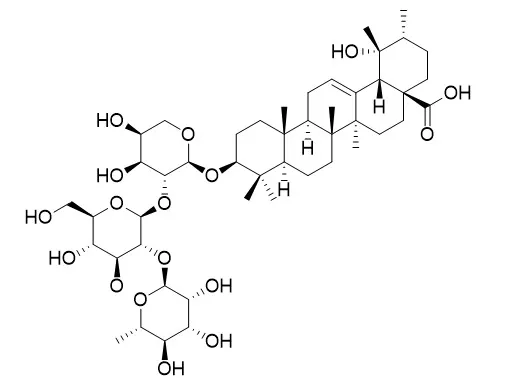In contrast to the extensively reported therapeutic activities, far less attention has been paid to the intestinal absorption of the total saponins from Radix Ilicis Pubescentis (in Chinese Mao-Dong-Qing, MDQ). This study aimed to investigate the intestinal absorption characteristics of ilexgenin A (C1), ilexsaponin A1 (C2), ilexsaponin B1 (C3), Ilexsaponin B2 (C4), ilexsaponin B3 (DC1), and ilexoside O (DC2) when administrated with the total saponins from MDQ (MDQ-TS).
METHODS AND RESULTS:
An UPLC method for simultaneous determination of C1, C2, C3, C4, DC1, and DC2 in intestinal outflow perfusate was developed and validated. The absorption characteristics of MDQ-TS were investigated by evaluating the effects of intestinal segments, drug concentration, P-glycoprotein (P-gp) inhibitor (verapomil), endocytosis inhibitor (amantadine) and ethylene diamine tetraacetic acid (EDTA, tight junction modulator) on the intestinal transportation of MDQ-TS by using a single-pass intestinal perfusion (SPIP) rat model, and the influence of co-existing components on the intestinal transport of the six saponins was discussed. The results showed that effective apparent permeability (Papp) of C1, C2, C3, C4, and DC2 administrated in MDQ-TS form had no segment-dependent changes at low and middle dosage levels. C1, C2, C3, D4, DC1, and DC2 administrated in MDQ-TS form all exhibited excellent transmembrane permeability with Papp > 0.12 × 10-2 cm·min-1. Meanwhile, Papp and effective absorption rate constant (Ka) values for the most saponins showed concentration dependence and saturation characteristics. After combining with P-gp inhibitor of verapamil, Papp of C2, C3, and DC1 in MDQ-TS group was significantly increased up to about 2.3-fold, 1.4-fold, and 3.4-fold, respectively in comparison to that of non-verapamil added group. Verapamil was found to improve the absorption of C2, C3, and DC1, indicating the involvement of an active transport mechanism in the absorption process. Compared with the non-amantadine added group, the absorption of C1, C2, C4, DC1, and DC2 were decreased by 40%, 71%, 31%, 53%, and 100%, respectively. Papp for the six target compounds increased up to about 1.2-2.1-fold in comparison with the non-EDTA added, respectively. The gastrointestinal transport of MDQ-TS could be greatly promoted by EDTA, and inhibited by amantadine, implying that the intestinal absorption of MDQ-TS was by passive diffusion and endocytosis process. Compared with monomer administration group, the intestinal absorption of C3, C4, DC1, and DC2 was significantly improved by co-existing components in MDQ-TS, and the non-absorbable saponins of C4, DC1, and DC2 unexpectedly showed sufficient intestinal permeability with Papp > 0.12 × 10-2 cm·min-1.
CONCLUSIONS:
This suggested that compounds orally administrated in TCM extract forms displayed unique intestinal absorption characteristics different from those of monomers, and the enhancing intestinal absorption of MDQ-TS reflected a holistic and specific view of traditional Chinese medicines (TCMs). |






 Cell. 2018 Jan 11;172(1-2):249-261.e12. doi: 10.1016/j.cell.2017.12.019.IF=36.216(2019)
Cell. 2018 Jan 11;172(1-2):249-261.e12. doi: 10.1016/j.cell.2017.12.019.IF=36.216(2019) Cell Metab. 2020 Mar 3;31(3):534-548.e5. doi: 10.1016/j.cmet.2020.01.002.IF=22.415(2019)
Cell Metab. 2020 Mar 3;31(3):534-548.e5. doi: 10.1016/j.cmet.2020.01.002.IF=22.415(2019) Mol Cell. 2017 Nov 16;68(4):673-685.e6. doi: 10.1016/j.molcel.2017.10.022.IF=14.548(2019)
Mol Cell. 2017 Nov 16;68(4):673-685.e6. doi: 10.1016/j.molcel.2017.10.022.IF=14.548(2019)